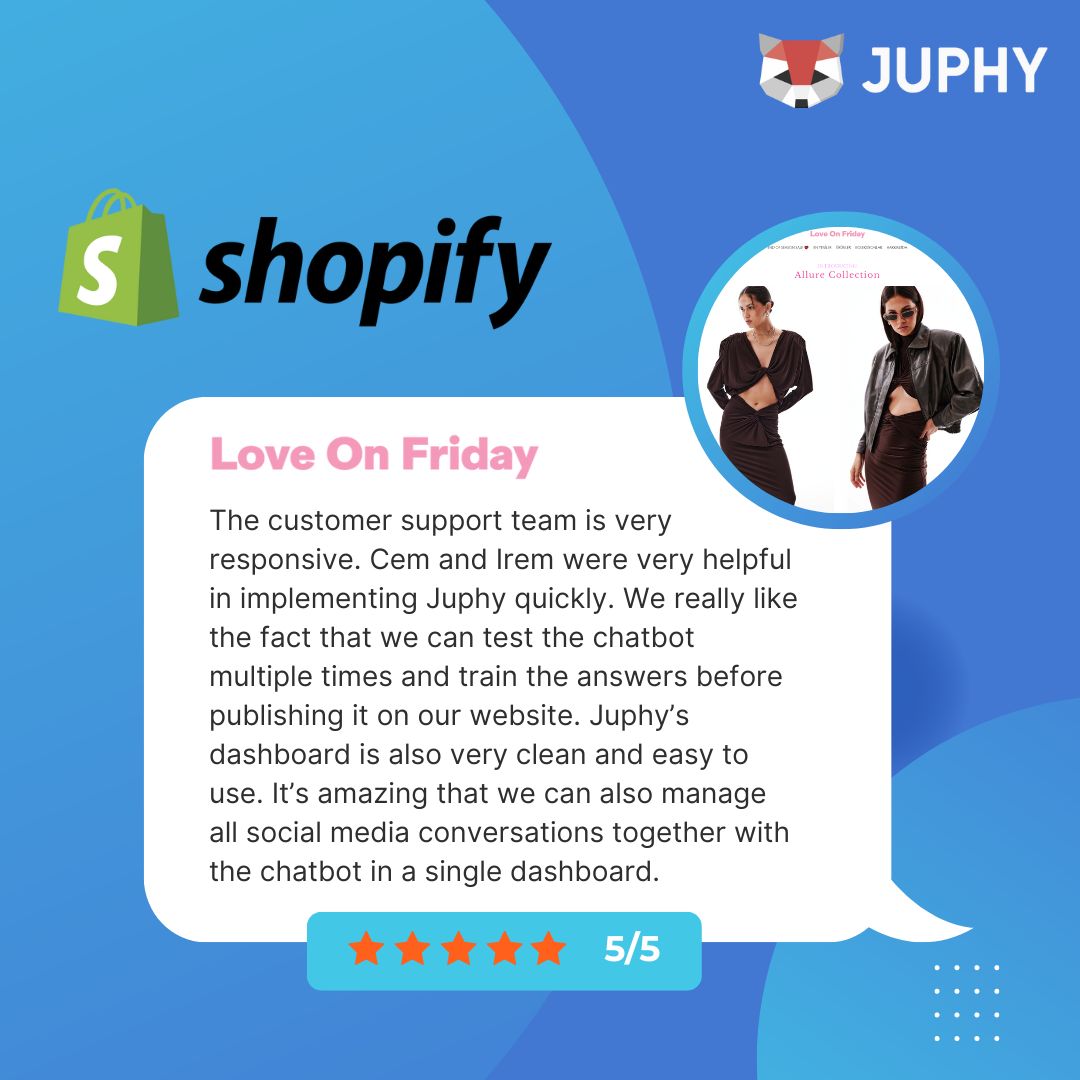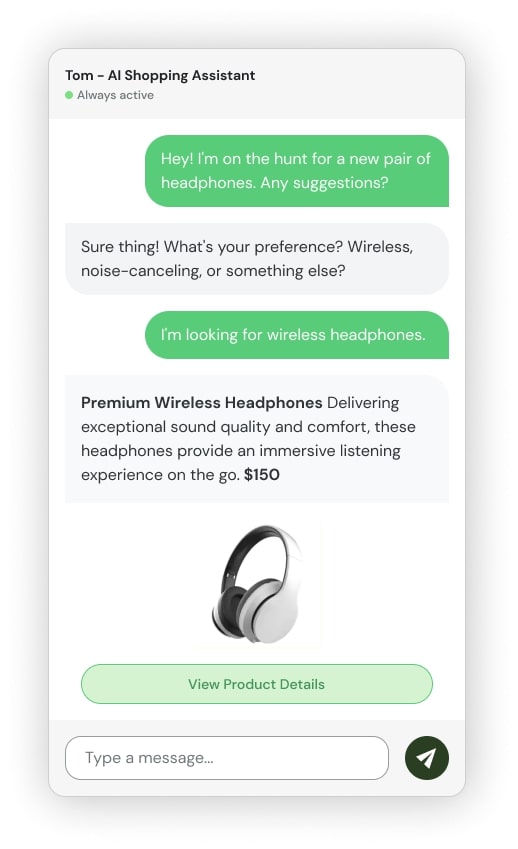Why Live Chat Is Not Enough For Your Shopify Store
Inci Vardar
A week before Mother’s Day, my mom mentioned a bag she saw on Instagram ads. Relieved from the stress of gift selection, I quickly ordered it, received an email confirmation, and began waiting eagerly. Mother’s Day came and went with just a bunch of flowers, as there was still no update on the shipment tracking page. Another week passed, and I decided to contact customer support. The brand had a live chat feature, which is now common on many e-commerce websites. Despite getting the answers I needed, the 5-minute response intervals felt like an eternity compared to my previous experiences with faster retailers. This highlighted for me why live chat may not be enough for your Shopify store and why exploring more advanced solutions is crucial to enhancing your customer service strategy.

What Are Live Chat Apps?
Live chat apps are text-based digital communication tools that are usually added as a plugin or embedded within the e-commerce website’s code. They enable real-time communication between customers and brands in their online stores and on social media. As a great alternative to phone calls or emails, live chat apps are designed to provide immediate customer support and resolve issues as they arise. While real-time messaging is the essential feature of all live chat apps, there are also common features that are designed to enhance speed and service quality.
Most Common Live Chat Features
- Notifications: Alerting you about every incoming live chat message and notifications received on desktop computers and mobile devices help you respond to requests quickly.
- Canned responses: Pre-programmed replies, such as greetings and answers to frequently asked questions, speed up your support team’s responses.
- File and link sharing: Most live chat apps allow the exchange of images, documents, and other files during the chat. With this feature, the support agent can offer specific products or understand an issue in full detail.
- Chat transcripts: Live chat apps save conversation histories for each visitor for future reference. They can help you keep track of the details of an ongoing issue or segment customers based on needs and pain points.
- Visitor tracking: Many live chat apps let you see the customers’ details, such as the browser, location, and other attributes you predefined. Some advanced apps also monitor user activity on the website to provide context for conversations.

The Limitations of Live Chat
Live chat offers numerous benefits, such as speed, efficiency, scalability, and support across a variety of channels. However, it also has several limitations that can impair customer service performance. Two main challenges of live chat require specific attention.
Challenges in Handling High Volumes of Inquiries
On a normal workday, customer support teams can respond to every message attentively and spend more time on a few problematic issues. But even the best-equipped support teams can be overwhelmed during peak seasons and promotional occasions like Mother’s Day. The longer the wait times, the more frustrated the customers get. This can result in increased cart abandonment and lost sales potential.

Limitations in Personalizing Customer Interactions
For a customer support agent, it is surely much less traumatizing to deal with a mean text message than a screaming customer, but this text-based communication style with a lighter emotional burden is a limitation in itself. Without the use of visual cues and verbal tone, the conversations are quick and sometimes prone to misunderstanding. So, following a predefined script becomes safer than showing empathy, and it can be challenging to establish a strong personal connection.
The Evolving Expectations of E-Commerce Customers
As technology advances and brands adopt innovative methods to improve the digital shopping experience, the customers adapt accordingly. In this circular evolution of increased demands followed by technological improvements, which leads to further expectations, customers become more discerning and expect higher standards from online retailers. To stay competitive, e-commerce businesses need to make constant improvements and meet the ever-rising expectations of their audience.
The Need for Instant and Accurate Responses
The modern customer orders food online about an hour before starving, believes that 6 business days is a perfectly sufficient period for a product that originated in China to be delivered halfway across the globe, and expects instant access to accurate answers so they can quickly resume their daily activities. So speed has become a concept of crucial importance. However, fast communication may not always provide the most accurate or detailed responses, especially if they are mostly automated.
Demand for Personalized Shopping Experiences
There is a rising demand for personalized shopping experiences as customers tend to shop from retailers who remember and act upon their needs, preferences, and interests. However, it is impossible for the human agents in your customer service team to memorize these details for each and every returning customer, let alone track every new visitor’s activity on the website to offer relevant products if needed. Today’s digital shoppers not only expect tailored recommendations and personalized offers but are also ready to increase their order value if the offers are relevant.
Expectations for Multichannel Support
Customers interact with brands using the simplest and fastest option available, and most of the time, sending a DM meets this criteria better than opening a browser, finding the brand’s website, and clicking on the little icon at the corner. Furthermore, just because they have chosen Instagram once to communicate with the brand does not necessarily mean that they will not change their preference towards email, website, WhatsApp, or the brand’s mobile application in the future. Today, customers expect seamless and consistent support regardless of the platform they use.
Thanks to advances in AI-powered technologies, chatbots can meet these expectations in a highly cost-efficient manner today.
Overcoming Prejudices Against E-Commerce Chatbots
Chatbots have been utilized for various purposes for quite some time, but earlier models that relied solely on predefined responses with a very limited capacity made them impractical and mostly undesirable from the customer’s point of view. It might be challenging to eliminate the prejudices towards chatbots completely, but recent advances in machine learning and natural language processing improved perspectives significantly.

Short History of Previous Chatbot Technologies
The first chatbots designed for e-commerce weren’t as effective as today’s modern, AI-powered versions. They were limited to basic, rule-based interactions and often provided robotic, unhelpful responses. Having no capacity for improvement through interaction, the earlier chatbots became yet another reason for customer frustration, leading to the current skepticism.
Human-like Interactions with ChatGPT-Powered Bots
The modern chatbots are powered by AI, which enables them to improve their knowledge and capabilities through interaction. Having a greater understanding of human language, the ChatGPT-powered bots can comprehend and respond to complex queries and mimic human interactions in natural, conversational dialogue. They are trained with huge amounts of data and can obtain information from various sources, enabling them to provide instant, accurate, and personalized responses.
Real-Life Examples of ChatGPT Power
Several e-commerce businesses have integrated ChatGPT-powered bots into their customer service practices across channels, and they utilize them for a variety of purposes. For example, a fashion retailer can now provide tailored product recommendations to their customers based on previous purchases, or a tech company can assist thousands of customers simultaneously with troubleshooting and product selection.
A real-life example demonstrating ChatGPT’s power is Expedia, a leading travel-planning brand. Expedia integrated conversational AI into its services in a way that feels like chatting with a friendly, knowledgeable travel agent instead of entering your search parameters in a box. This integration adds a personal touch to the vacation-planning process and makes customers even more satisfied by automatically creating smart lists of hotels and attractions.

Another example of successful implementation is the UK-based energy supplier Octopus Energy. According to Greg Johnson, the chief executive of Octopus Energy, the ChatGPT-powered technology is doing the work of 250 people, and customers are more satisfied with AI bots answering their emails than humans.
If you are interested in building a similar success story with your Shopify store, read on to meet Juphy AI, the ChatGPT-powered AI Agent that can serve your customers 24/7 and increase sales by up to 10x.
Juphy AI Features That Showcase ChatGPT
Equipped with the latest AI technologies, the ChatGPT-powered sales and support assistant Juphy AI seamlessly manages the entire sales process, from the first DM to post-sale follow-up. Juphy’s AI Agent is easily managed from the Shopify dashboard, thanks to its ‘Built for Shopify’ badge. It excels in three areas to meet the evolving expectations of the modern e-commerce customer.

Personalized Product Recommendations Using Shopify Tags
Juphy AI scans your entire Shopify store website upon deployment, gathers product information in seconds, and utilizes the assigned tags to analyze customer behavior for tailored product recommendations. By analyzing accumulated customer data, including browsing patterns and interactions, Juphy’s AI Agent can recommend related products, enhance average order value, make personalized suggestions based on past purchases, and retarget customers with precision.

Providing Information on Order Tracking
Juphy’s AI Agent is always ready to assist your customers through their post-purchase issues, day or night. Understanding the intricate nuances in language and asking the right questions, it answers questions instantly and accurately. Juphy AI ensures that your Shopify store is always responsive and enhances customer satisfaction both during and after the sales process.

Responding to Customer Queries Like a Human Assistant
Juphy AI is designed to perfectly mimic your brand tone of voice when serving your customers. While it learns from your website data and customer interactions, it can also be edited and trained to meet your needs better. With ChatGPT’s excellent command of language patterns, Juphy’s AI Agent responds to customer queries like a sympathetic human assistant.
Conclusion
Supporting customers with a live chat function and a human crew may seem sufficient for you now, even though it becomes a little challenging during peak periods. But you should keep in mind that you are losing a significant portion of your sales potential without a 24/7 available sales assistant. While live chat apps are a valuable tool for customer support, they are not enough to meet the instance, accuracy, personalization, and accessibility demands of the e-commerce customer. You can enhance your sales and support capabilities with the correct tools and deliver superior shopping experiences.
Key Takeaways
- Live chat is a valuable tool for faster customer support, but it struggles to handle high volumes of inquiries and personalized interactions, leading to potential sales loss.
- Modern e-commerce customers expect rapid and accurate responses, personalized shopping experiences, and seamless multichannel support. Live chat alone often fails to meet these high standards.
- Advances in AI, particularly with ChatGPT-powered bots, have significantly improved customer service by providing human-like interactions, instant and accurate responses, and tailored product recommendations.
- Advanced bots, such as ChatGPT-powered Juphy’s AI Agent, can manage both support and sales processes, not only streamlining operations but also boosting team productivity.


